Nursing Article Appraisal: Training for Nursing Students
VerifiedAdded on 2022/09/18
|9
|2467
|173
Report
AI Summary
This report critically appraises the study by Sanner-Stiehr (2018), which investigated the impact of cognitive rehearsal (CR) training on nursing students' ability to respond to disruptive behaviors. The appraisal examines the study's introduction, literature review, research problem, purpose, research questions, theoretical framework (Social Cognitive Theory), variables, and research design (longitudinal quasi-experimental). The report highlights the strengths, such as the clear title, well-structured abstract, and the relevance of the research to addressing nursing turnover and quality of care. Weaknesses identified include the lack of critical review of all papers in the literature review and a limited link between the theoretical framework and the research problem. The study's use of the Self-Efficacy to Respond to Disruptive Behaviors (SERDB) questionnaire is noted, along with the appropriateness of the longitudinal quasi-experimental design. The appraisal also touches upon the sampling method, inclusion/exclusion criteria, sample size, and the setting's suitability. The report concludes with a comprehensive overview of the study's components, offering a detailed analysis of its methodology, findings, and implications.
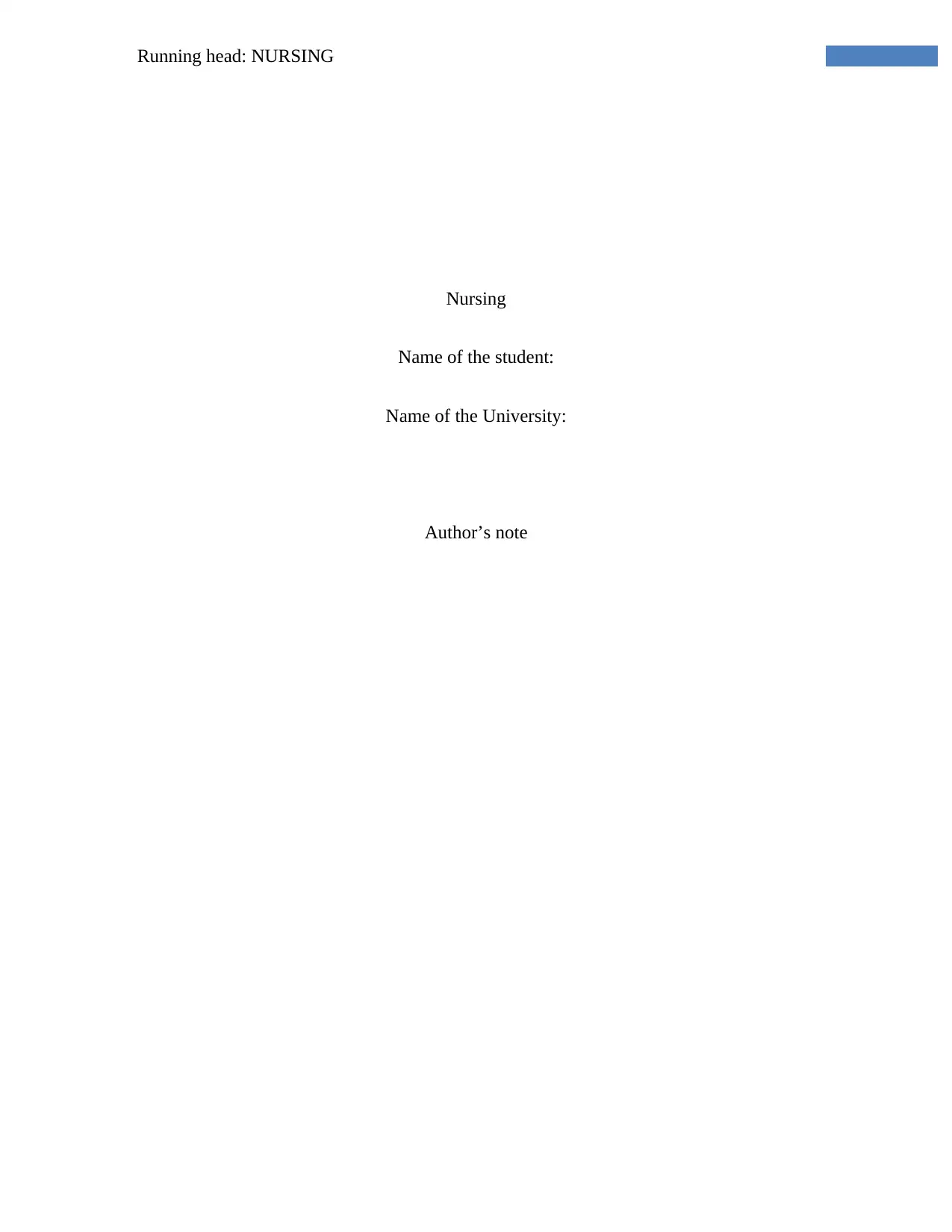
Running head: NURSING
Nursing
Name of the student:
Name of the University:
Author’s note
Nursing
Name of the student:
Name of the University:
Author’s note
Paraphrase This Document
Need a fresh take? Get an instant paraphrase of this document with our AI Paraphraser
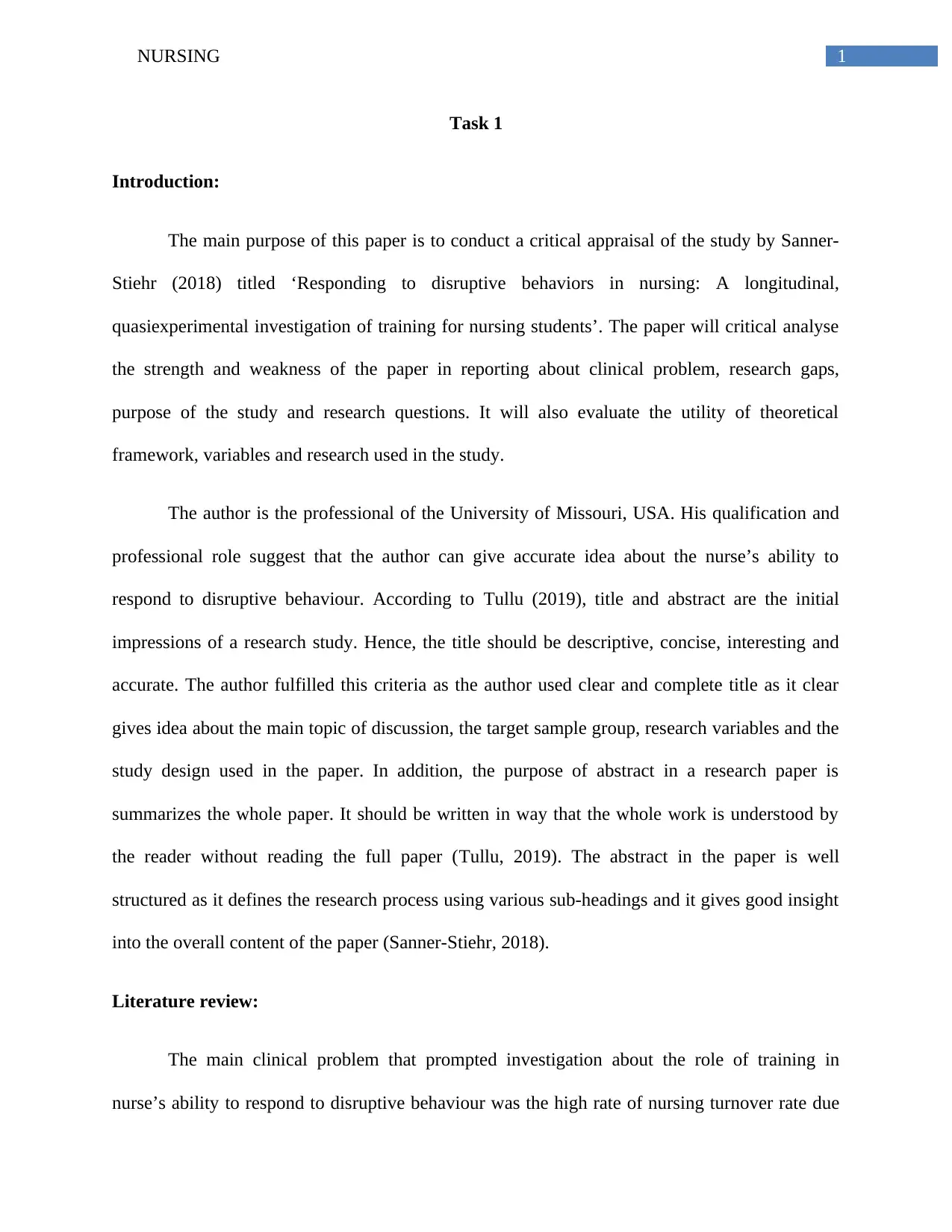
1NURSING
Task 1
Introduction:
The main purpose of this paper is to conduct a critical appraisal of the study by Sanner-
Stiehr (2018) titled ‘Responding to disruptive behaviors in nursing: A longitudinal,
quasiexperimental investigation of training for nursing students’. The paper will critical analyse
the strength and weakness of the paper in reporting about clinical problem, research gaps,
purpose of the study and research questions. It will also evaluate the utility of theoretical
framework, variables and research used in the study.
The author is the professional of the University of Missouri, USA. His qualification and
professional role suggest that the author can give accurate idea about the nurse’s ability to
respond to disruptive behaviour. According to Tullu (2019), title and abstract are the initial
impressions of a research study. Hence, the title should be descriptive, concise, interesting and
accurate. The author fulfilled this criteria as the author used clear and complete title as it clear
gives idea about the main topic of discussion, the target sample group, research variables and the
study design used in the paper. In addition, the purpose of abstract in a research paper is
summarizes the whole paper. It should be written in way that the whole work is understood by
the reader without reading the full paper (Tullu, 2019). The abstract in the paper is well
structured as it defines the research process using various sub-headings and it gives good insight
into the overall content of the paper (Sanner-Stiehr, 2018).
Literature review:
The main clinical problem that prompted investigation about the role of training in
nurse’s ability to respond to disruptive behaviour was the high rate of nursing turnover rate due
Task 1
Introduction:
The main purpose of this paper is to conduct a critical appraisal of the study by Sanner-
Stiehr (2018) titled ‘Responding to disruptive behaviors in nursing: A longitudinal,
quasiexperimental investigation of training for nursing students’. The paper will critical analyse
the strength and weakness of the paper in reporting about clinical problem, research gaps,
purpose of the study and research questions. It will also evaluate the utility of theoretical
framework, variables and research used in the study.
The author is the professional of the University of Missouri, USA. His qualification and
professional role suggest that the author can give accurate idea about the nurse’s ability to
respond to disruptive behaviour. According to Tullu (2019), title and abstract are the initial
impressions of a research study. Hence, the title should be descriptive, concise, interesting and
accurate. The author fulfilled this criteria as the author used clear and complete title as it clear
gives idea about the main topic of discussion, the target sample group, research variables and the
study design used in the paper. In addition, the purpose of abstract in a research paper is
summarizes the whole paper. It should be written in way that the whole work is understood by
the reader without reading the full paper (Tullu, 2019). The abstract in the paper is well
structured as it defines the research process using various sub-headings and it gives good insight
into the overall content of the paper (Sanner-Stiehr, 2018).
Literature review:
The main clinical problem that prompted investigation about the role of training in
nurse’s ability to respond to disruptive behaviour was the high rate of nursing turnover rate due
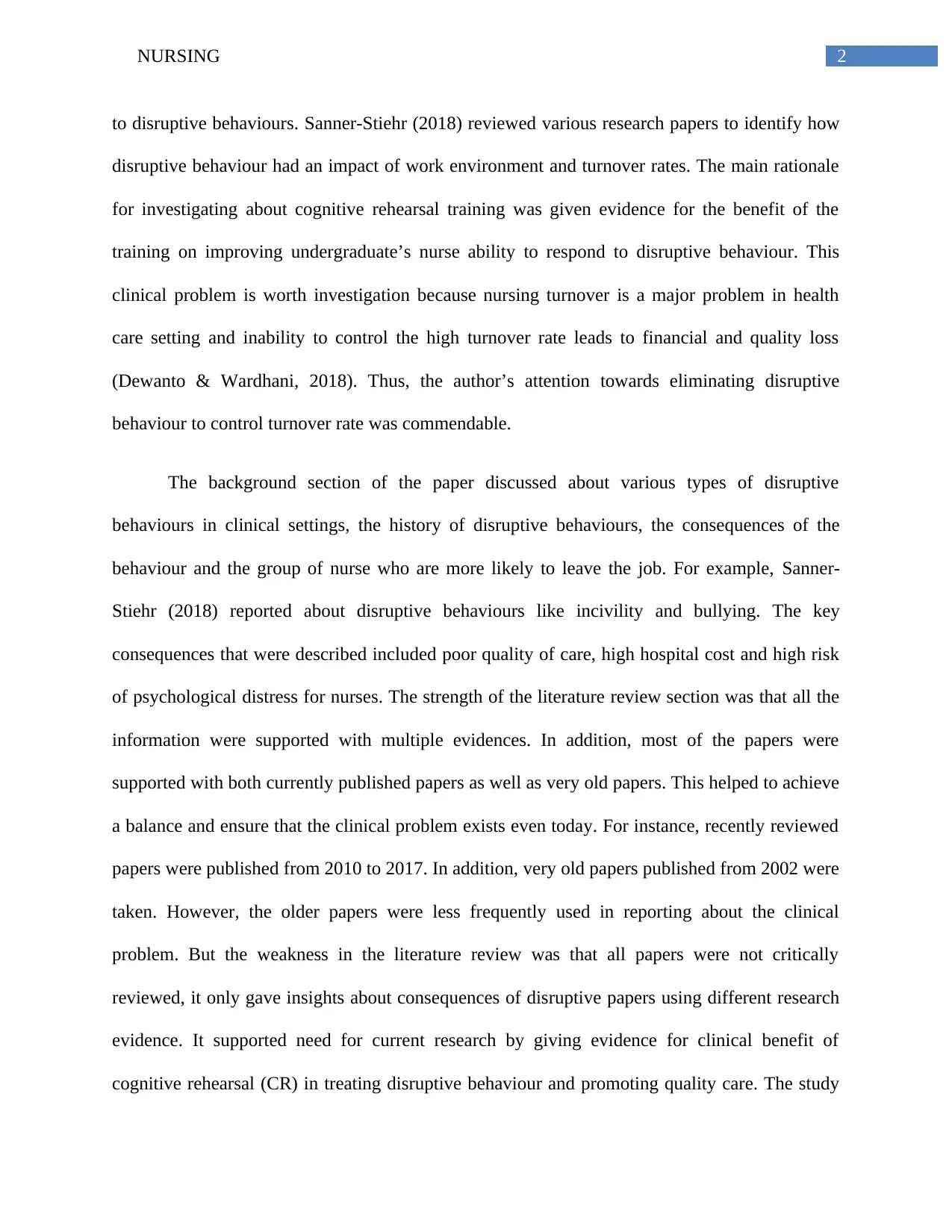
2NURSING
to disruptive behaviours. Sanner-Stiehr (2018) reviewed various research papers to identify how
disruptive behaviour had an impact of work environment and turnover rates. The main rationale
for investigating about cognitive rehearsal training was given evidence for the benefit of the
training on improving undergraduate’s nurse ability to respond to disruptive behaviour. This
clinical problem is worth investigation because nursing turnover is a major problem in health
care setting and inability to control the high turnover rate leads to financial and quality loss
(Dewanto & Wardhani, 2018). Thus, the author’s attention towards eliminating disruptive
behaviour to control turnover rate was commendable.
The background section of the paper discussed about various types of disruptive
behaviours in clinical settings, the history of disruptive behaviours, the consequences of the
behaviour and the group of nurse who are more likely to leave the job. For example, Sanner-
Stiehr (2018) reported about disruptive behaviours like incivility and bullying. The key
consequences that were described included poor quality of care, high hospital cost and high risk
of psychological distress for nurses. The strength of the literature review section was that all the
information were supported with multiple evidences. In addition, most of the papers were
supported with both currently published papers as well as very old papers. This helped to achieve
a balance and ensure that the clinical problem exists even today. For instance, recently reviewed
papers were published from 2010 to 2017. In addition, very old papers published from 2002 were
taken. However, the older papers were less frequently used in reporting about the clinical
problem. But the weakness in the literature review was that all papers were not critically
reviewed, it only gave insights about consequences of disruptive papers using different research
evidence. It supported need for current research by giving evidence for clinical benefit of
cognitive rehearsal (CR) in treating disruptive behaviour and promoting quality care. The study
to disruptive behaviours. Sanner-Stiehr (2018) reviewed various research papers to identify how
disruptive behaviour had an impact of work environment and turnover rates. The main rationale
for investigating about cognitive rehearsal training was given evidence for the benefit of the
training on improving undergraduate’s nurse ability to respond to disruptive behaviour. This
clinical problem is worth investigation because nursing turnover is a major problem in health
care setting and inability to control the high turnover rate leads to financial and quality loss
(Dewanto & Wardhani, 2018). Thus, the author’s attention towards eliminating disruptive
behaviour to control turnover rate was commendable.
The background section of the paper discussed about various types of disruptive
behaviours in clinical settings, the history of disruptive behaviours, the consequences of the
behaviour and the group of nurse who are more likely to leave the job. For example, Sanner-
Stiehr (2018) reported about disruptive behaviours like incivility and bullying. The key
consequences that were described included poor quality of care, high hospital cost and high risk
of psychological distress for nurses. The strength of the literature review section was that all the
information were supported with multiple evidences. In addition, most of the papers were
supported with both currently published papers as well as very old papers. This helped to achieve
a balance and ensure that the clinical problem exists even today. For instance, recently reviewed
papers were published from 2010 to 2017. In addition, very old papers published from 2002 were
taken. However, the older papers were less frequently used in reporting about the clinical
problem. But the weakness in the literature review was that all papers were not critically
reviewed, it only gave insights about consequences of disruptive papers using different research
evidence. It supported need for current research by giving evidence for clinical benefit of
cognitive rehearsal (CR) in treating disruptive behaviour and promoting quality care. The study
⊘ This is a preview!⊘
Do you want full access?
Subscribe today to unlock all pages.

Trusted by 1+ million students worldwide
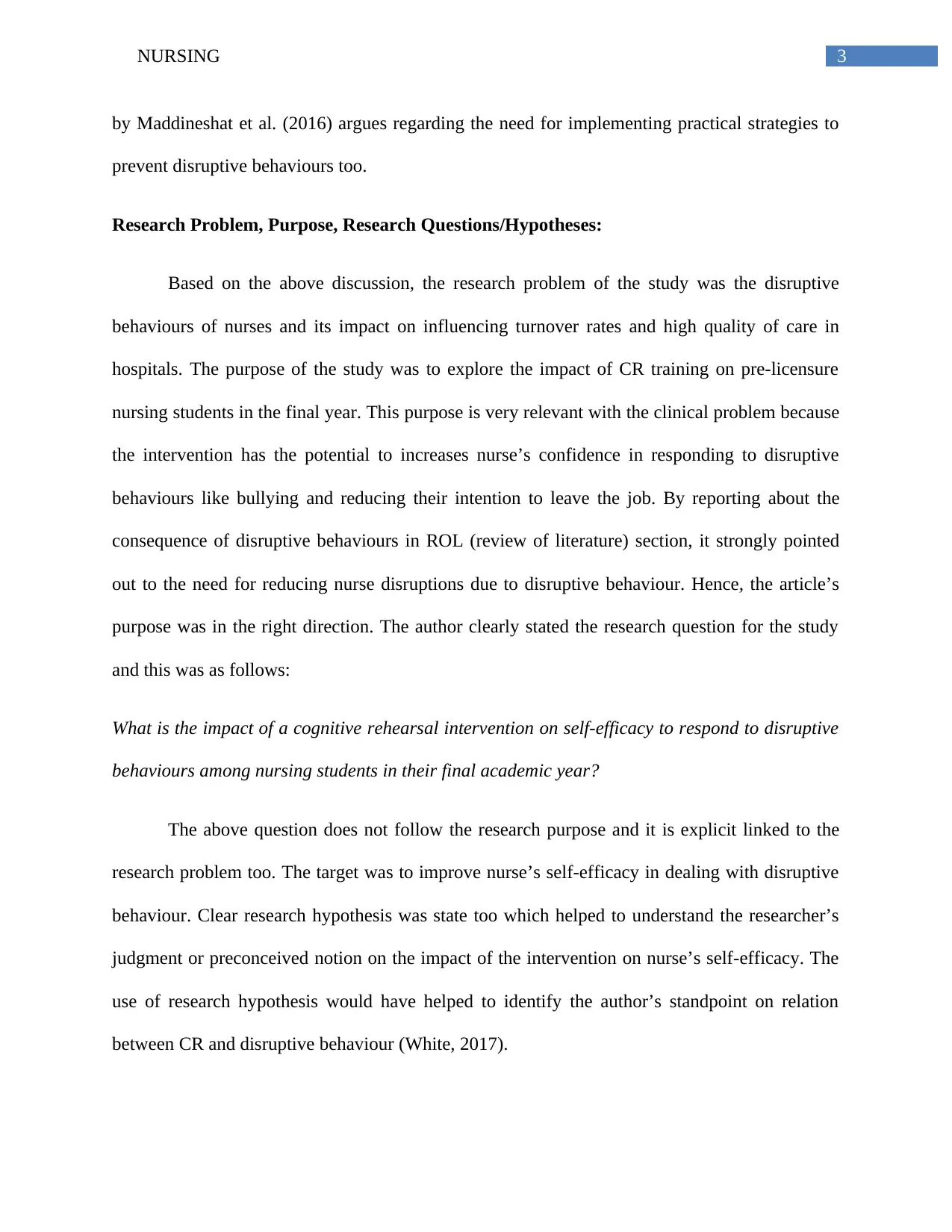
3NURSING
by Maddineshat et al. (2016) argues regarding the need for implementing practical strategies to
prevent disruptive behaviours too.
Research Problem, Purpose, Research Questions/Hypotheses:
Based on the above discussion, the research problem of the study was the disruptive
behaviours of nurses and its impact on influencing turnover rates and high quality of care in
hospitals. The purpose of the study was to explore the impact of CR training on pre-licensure
nursing students in the final year. This purpose is very relevant with the clinical problem because
the intervention has the potential to increases nurse’s confidence in responding to disruptive
behaviours like bullying and reducing their intention to leave the job. By reporting about the
consequence of disruptive behaviours in ROL (review of literature) section, it strongly pointed
out to the need for reducing nurse disruptions due to disruptive behaviour. Hence, the article’s
purpose was in the right direction. The author clearly stated the research question for the study
and this was as follows:
What is the impact of a cognitive rehearsal intervention on self-efficacy to respond to disruptive
behaviours among nursing students in their final academic year?
The above question does not follow the research purpose and it is explicit linked to the
research problem too. The target was to improve nurse’s self-efficacy in dealing with disruptive
behaviour. Clear research hypothesis was state too which helped to understand the researcher’s
judgment or preconceived notion on the impact of the intervention on nurse’s self-efficacy. The
use of research hypothesis would have helped to identify the author’s standpoint on relation
between CR and disruptive behaviour (White, 2017).
by Maddineshat et al. (2016) argues regarding the need for implementing practical strategies to
prevent disruptive behaviours too.
Research Problem, Purpose, Research Questions/Hypotheses:
Based on the above discussion, the research problem of the study was the disruptive
behaviours of nurses and its impact on influencing turnover rates and high quality of care in
hospitals. The purpose of the study was to explore the impact of CR training on pre-licensure
nursing students in the final year. This purpose is very relevant with the clinical problem because
the intervention has the potential to increases nurse’s confidence in responding to disruptive
behaviours like bullying and reducing their intention to leave the job. By reporting about the
consequence of disruptive behaviours in ROL (review of literature) section, it strongly pointed
out to the need for reducing nurse disruptions due to disruptive behaviour. Hence, the article’s
purpose was in the right direction. The author clearly stated the research question for the study
and this was as follows:
What is the impact of a cognitive rehearsal intervention on self-efficacy to respond to disruptive
behaviours among nursing students in their final academic year?
The above question does not follow the research purpose and it is explicit linked to the
research problem too. The target was to improve nurse’s self-efficacy in dealing with disruptive
behaviour. Clear research hypothesis was state too which helped to understand the researcher’s
judgment or preconceived notion on the impact of the intervention on nurse’s self-efficacy. The
use of research hypothesis would have helped to identify the author’s standpoint on relation
between CR and disruptive behaviour (White, 2017).
Paraphrase This Document
Need a fresh take? Get an instant paraphrase of this document with our AI Paraphraser
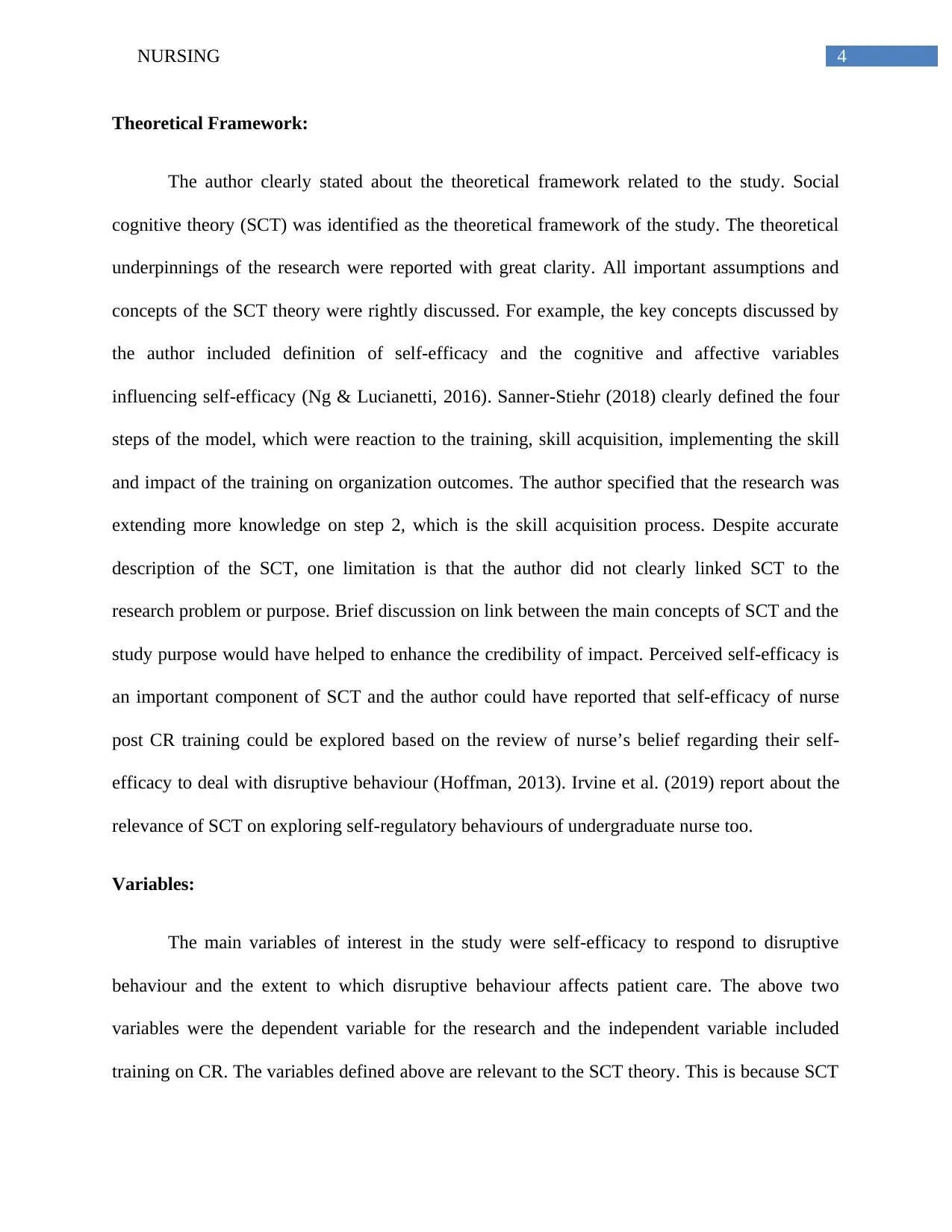
4NURSING
Theoretical Framework:
The author clearly stated about the theoretical framework related to the study. Social
cognitive theory (SCT) was identified as the theoretical framework of the study. The theoretical
underpinnings of the research were reported with great clarity. All important assumptions and
concepts of the SCT theory were rightly discussed. For example, the key concepts discussed by
the author included definition of self-efficacy and the cognitive and affective variables
influencing self-efficacy (Ng & Lucianetti, 2016). Sanner-Stiehr (2018) clearly defined the four
steps of the model, which were reaction to the training, skill acquisition, implementing the skill
and impact of the training on organization outcomes. The author specified that the research was
extending more knowledge on step 2, which is the skill acquisition process. Despite accurate
description of the SCT, one limitation is that the author did not clearly linked SCT to the
research problem or purpose. Brief discussion on link between the main concepts of SCT and the
study purpose would have helped to enhance the credibility of impact. Perceived self-efficacy is
an important component of SCT and the author could have reported that self-efficacy of nurse
post CR training could be explored based on the review of nurse’s belief regarding their self-
efficacy to deal with disruptive behaviour (Hoffman, 2013). Irvine et al. (2019) report about the
relevance of SCT on exploring self-regulatory behaviours of undergraduate nurse too.
Variables:
The main variables of interest in the study were self-efficacy to respond to disruptive
behaviour and the extent to which disruptive behaviour affects patient care. The above two
variables were the dependent variable for the research and the independent variable included
training on CR. The variables defined above are relevant to the SCT theory. This is because SCT
Theoretical Framework:
The author clearly stated about the theoretical framework related to the study. Social
cognitive theory (SCT) was identified as the theoretical framework of the study. The theoretical
underpinnings of the research were reported with great clarity. All important assumptions and
concepts of the SCT theory were rightly discussed. For example, the key concepts discussed by
the author included definition of self-efficacy and the cognitive and affective variables
influencing self-efficacy (Ng & Lucianetti, 2016). Sanner-Stiehr (2018) clearly defined the four
steps of the model, which were reaction to the training, skill acquisition, implementing the skill
and impact of the training on organization outcomes. The author specified that the research was
extending more knowledge on step 2, which is the skill acquisition process. Despite accurate
description of the SCT, one limitation is that the author did not clearly linked SCT to the
research problem or purpose. Brief discussion on link between the main concepts of SCT and the
study purpose would have helped to enhance the credibility of impact. Perceived self-efficacy is
an important component of SCT and the author could have reported that self-efficacy of nurse
post CR training could be explored based on the review of nurse’s belief regarding their self-
efficacy to deal with disruptive behaviour (Hoffman, 2013). Irvine et al. (2019) report about the
relevance of SCT on exploring self-regulatory behaviours of undergraduate nurse too.
Variables:
The main variables of interest in the study were self-efficacy to respond to disruptive
behaviour and the extent to which disruptive behaviour affects patient care. The above two
variables were the dependent variable for the research and the independent variable included
training on CR. The variables defined above are relevant to the SCT theory. This is because SCT
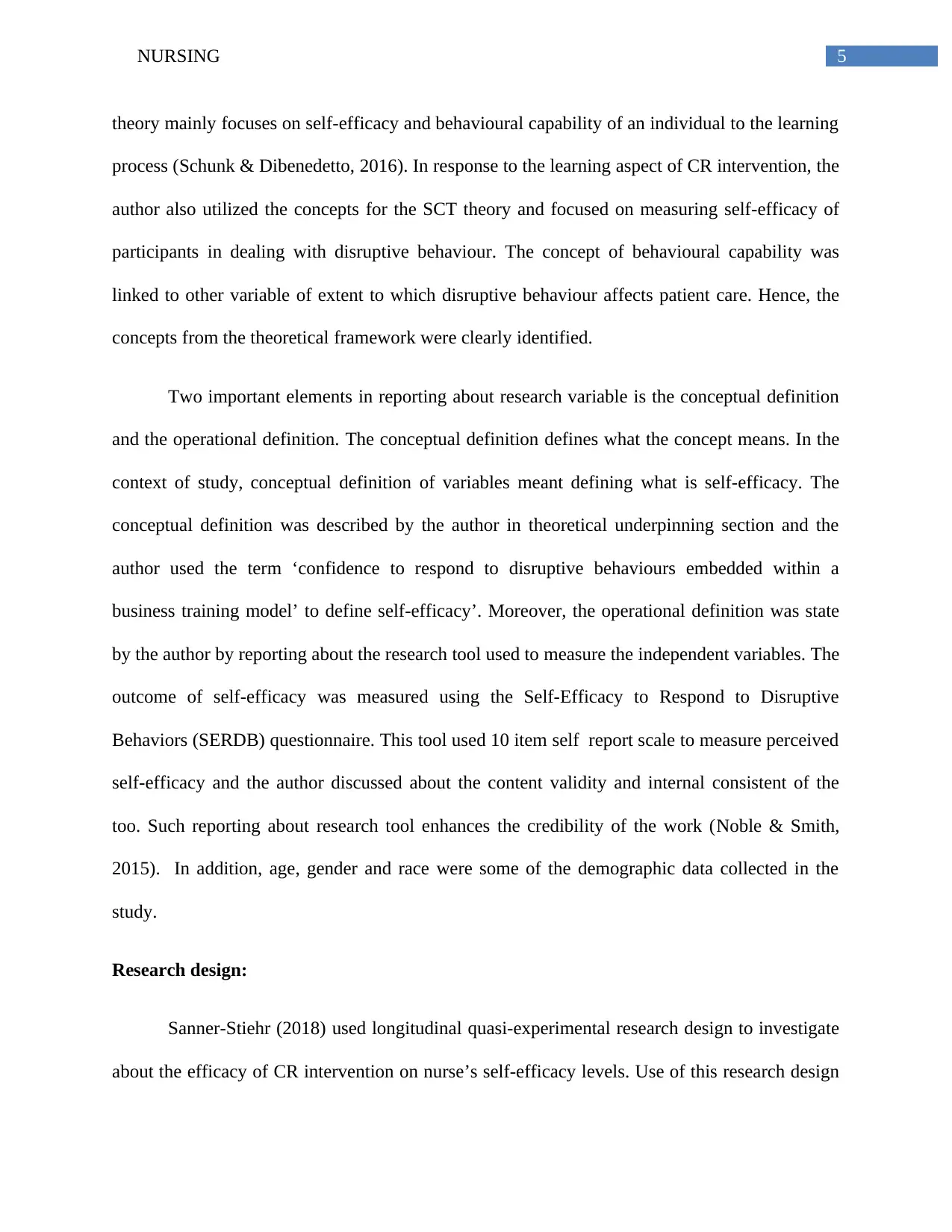
5NURSING
theory mainly focuses on self-efficacy and behavioural capability of an individual to the learning
process (Schunk & Dibenedetto, 2016). In response to the learning aspect of CR intervention, the
author also utilized the concepts for the SCT theory and focused on measuring self-efficacy of
participants in dealing with disruptive behaviour. The concept of behavioural capability was
linked to other variable of extent to which disruptive behaviour affects patient care. Hence, the
concepts from the theoretical framework were clearly identified.
Two important elements in reporting about research variable is the conceptual definition
and the operational definition. The conceptual definition defines what the concept means. In the
context of study, conceptual definition of variables meant defining what is self-efficacy. The
conceptual definition was described by the author in theoretical underpinning section and the
author used the term ‘confidence to respond to disruptive behaviours embedded within a
business training model’ to define self-efficacy’. Moreover, the operational definition was state
by the author by reporting about the research tool used to measure the independent variables. The
outcome of self-efficacy was measured using the Self-Efficacy to Respond to Disruptive
Behaviors (SERDB) questionnaire. This tool used 10 item self report scale to measure perceived
self-efficacy and the author discussed about the content validity and internal consistent of the
too. Such reporting about research tool enhances the credibility of the work (Noble & Smith,
2015). In addition, age, gender and race were some of the demographic data collected in the
study.
Research design:
Sanner-Stiehr (2018) used longitudinal quasi-experimental research design to investigate
about the efficacy of CR intervention on nurse’s self-efficacy levels. Use of this research design
theory mainly focuses on self-efficacy and behavioural capability of an individual to the learning
process (Schunk & Dibenedetto, 2016). In response to the learning aspect of CR intervention, the
author also utilized the concepts for the SCT theory and focused on measuring self-efficacy of
participants in dealing with disruptive behaviour. The concept of behavioural capability was
linked to other variable of extent to which disruptive behaviour affects patient care. Hence, the
concepts from the theoretical framework were clearly identified.
Two important elements in reporting about research variable is the conceptual definition
and the operational definition. The conceptual definition defines what the concept means. In the
context of study, conceptual definition of variables meant defining what is self-efficacy. The
conceptual definition was described by the author in theoretical underpinning section and the
author used the term ‘confidence to respond to disruptive behaviours embedded within a
business training model’ to define self-efficacy’. Moreover, the operational definition was state
by the author by reporting about the research tool used to measure the independent variables. The
outcome of self-efficacy was measured using the Self-Efficacy to Respond to Disruptive
Behaviors (SERDB) questionnaire. This tool used 10 item self report scale to measure perceived
self-efficacy and the author discussed about the content validity and internal consistent of the
too. Such reporting about research tool enhances the credibility of the work (Noble & Smith,
2015). In addition, age, gender and race were some of the demographic data collected in the
study.
Research design:
Sanner-Stiehr (2018) used longitudinal quasi-experimental research design to investigate
about the efficacy of CR intervention on nurse’s self-efficacy levels. Use of this research design
⊘ This is a preview!⊘
Do you want full access?
Subscribe today to unlock all pages.

Trusted by 1+ million students worldwide
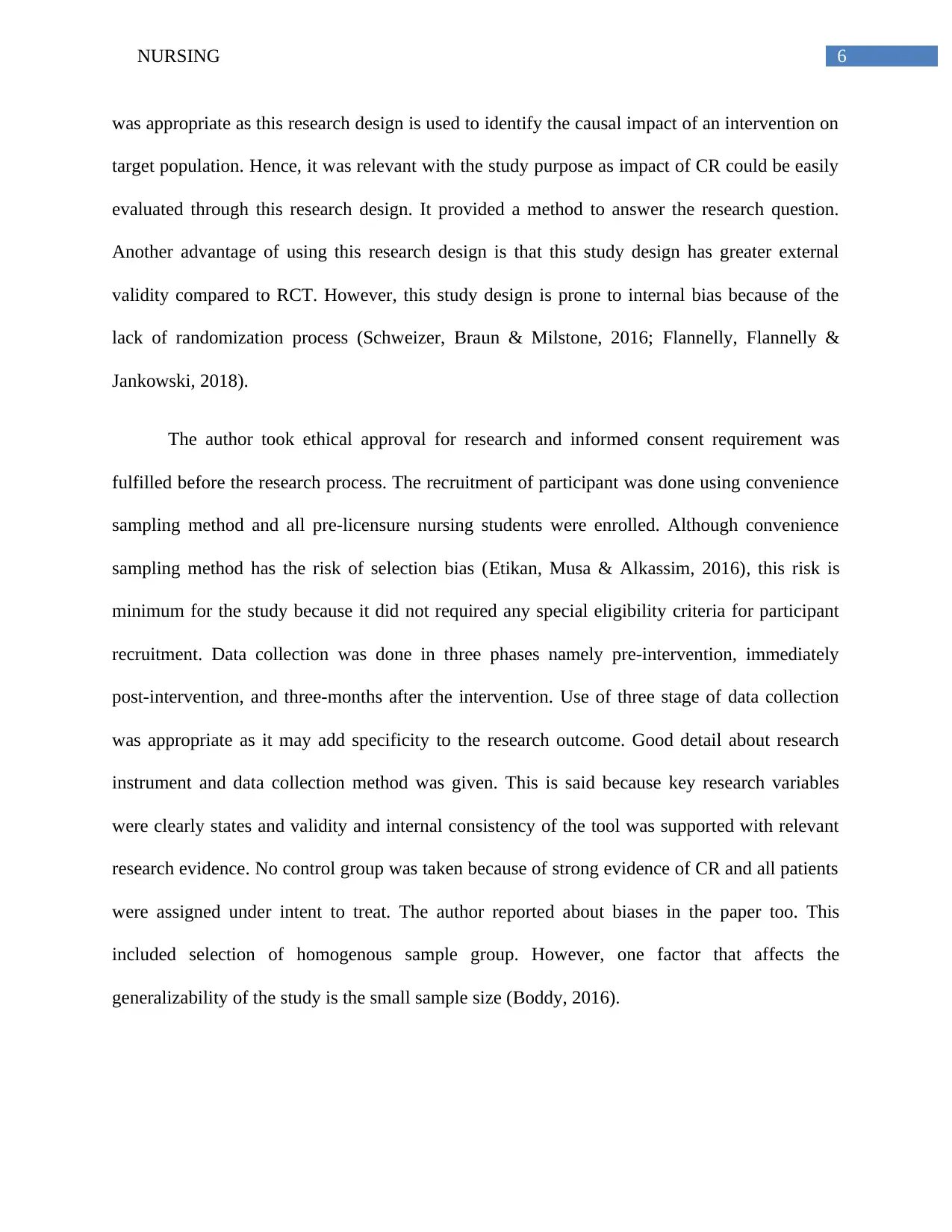
6NURSING
was appropriate as this research design is used to identify the causal impact of an intervention on
target population. Hence, it was relevant with the study purpose as impact of CR could be easily
evaluated through this research design. It provided a method to answer the research question.
Another advantage of using this research design is that this study design has greater external
validity compared to RCT. However, this study design is prone to internal bias because of the
lack of randomization process (Schweizer, Braun & Milstone, 2016; Flannelly, Flannelly &
Jankowski, 2018).
The author took ethical approval for research and informed consent requirement was
fulfilled before the research process. The recruitment of participant was done using convenience
sampling method and all pre-licensure nursing students were enrolled. Although convenience
sampling method has the risk of selection bias (Etikan, Musa & Alkassim, 2016), this risk is
minimum for the study because it did not required any special eligibility criteria for participant
recruitment. Data collection was done in three phases namely pre-intervention, immediately
post-intervention, and three-months after the intervention. Use of three stage of data collection
was appropriate as it may add specificity to the research outcome. Good detail about research
instrument and data collection method was given. This is said because key research variables
were clearly states and validity and internal consistency of the tool was supported with relevant
research evidence. No control group was taken because of strong evidence of CR and all patients
were assigned under intent to treat. The author reported about biases in the paper too. This
included selection of homogenous sample group. However, one factor that affects the
generalizability of the study is the small sample size (Boddy, 2016).
was appropriate as this research design is used to identify the causal impact of an intervention on
target population. Hence, it was relevant with the study purpose as impact of CR could be easily
evaluated through this research design. It provided a method to answer the research question.
Another advantage of using this research design is that this study design has greater external
validity compared to RCT. However, this study design is prone to internal bias because of the
lack of randomization process (Schweizer, Braun & Milstone, 2016; Flannelly, Flannelly &
Jankowski, 2018).
The author took ethical approval for research and informed consent requirement was
fulfilled before the research process. The recruitment of participant was done using convenience
sampling method and all pre-licensure nursing students were enrolled. Although convenience
sampling method has the risk of selection bias (Etikan, Musa & Alkassim, 2016), this risk is
minimum for the study because it did not required any special eligibility criteria for participant
recruitment. Data collection was done in three phases namely pre-intervention, immediately
post-intervention, and three-months after the intervention. Use of three stage of data collection
was appropriate as it may add specificity to the research outcome. Good detail about research
instrument and data collection method was given. This is said because key research variables
were clearly states and validity and internal consistency of the tool was supported with relevant
research evidence. No control group was taken because of strong evidence of CR and all patients
were assigned under intent to treat. The author reported about biases in the paper too. This
included selection of homogenous sample group. However, one factor that affects the
generalizability of the study is the small sample size (Boddy, 2016).
Paraphrase This Document
Need a fresh take? Get an instant paraphrase of this document with our AI Paraphraser
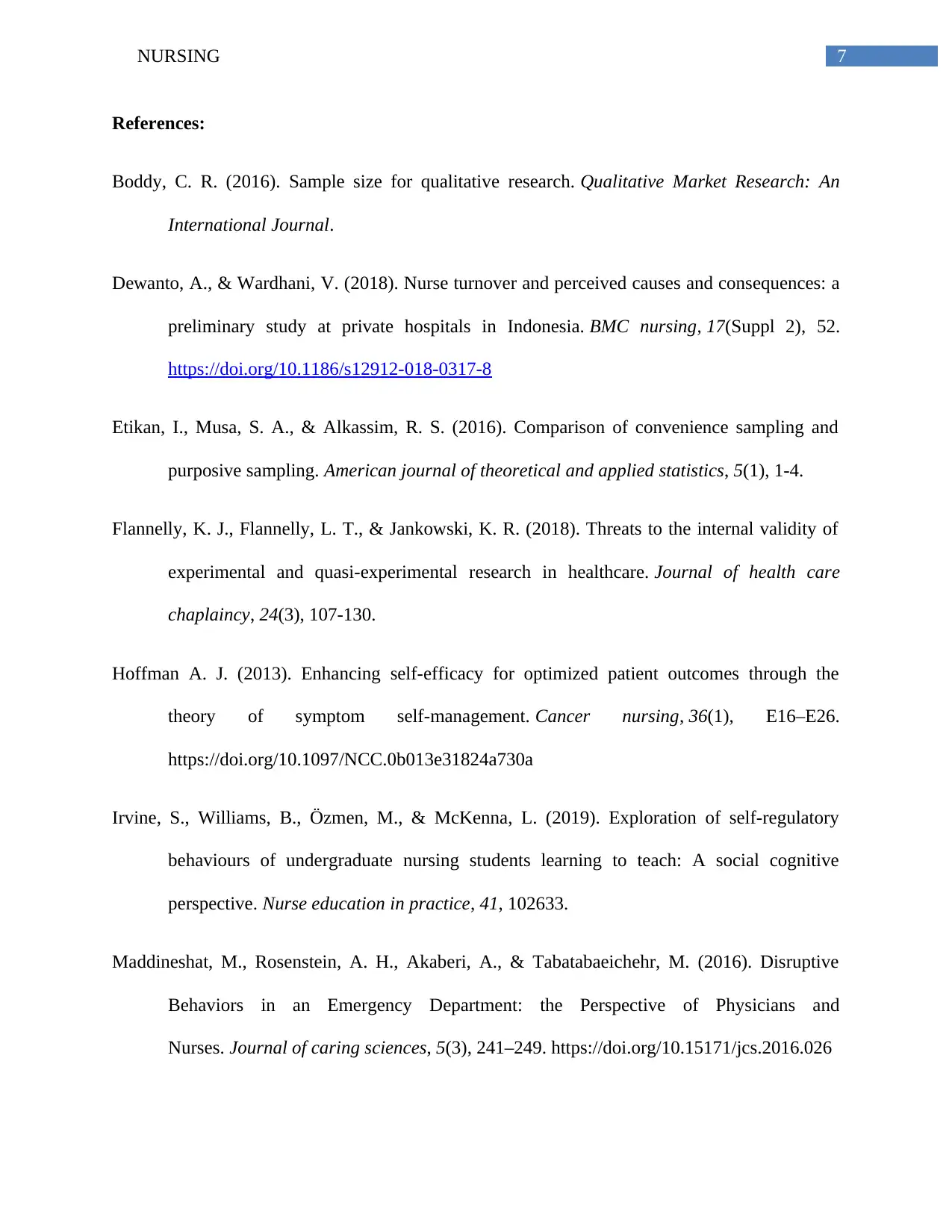
7NURSING
References:
Boddy, C. R. (2016). Sample size for qualitative research. Qualitative Market Research: An
International Journal.
Dewanto, A., & Wardhani, V. (2018). Nurse turnover and perceived causes and consequences: a
preliminary study at private hospitals in Indonesia. BMC nursing, 17(Suppl 2), 52.
https://doi.org/10.1186/s12912-018-0317-8
Etikan, I., Musa, S. A., & Alkassim, R. S. (2016). Comparison of convenience sampling and
purposive sampling. American journal of theoretical and applied statistics, 5(1), 1-4.
Flannelly, K. J., Flannelly, L. T., & Jankowski, K. R. (2018). Threats to the internal validity of
experimental and quasi-experimental research in healthcare. Journal of health care
chaplaincy, 24(3), 107-130.
Hoffman A. J. (2013). Enhancing self-efficacy for optimized patient outcomes through the
theory of symptom self-management. Cancer nursing, 36(1), E16–E26.
https://doi.org/10.1097/NCC.0b013e31824a730a
Irvine, S., Williams, B., Özmen, M., & McKenna, L. (2019). Exploration of self-regulatory
behaviours of undergraduate nursing students learning to teach: A social cognitive
perspective. Nurse education in practice, 41, 102633.
Maddineshat, M., Rosenstein, A. H., Akaberi, A., & Tabatabaeichehr, M. (2016). Disruptive
Behaviors in an Emergency Department: the Perspective of Physicians and
Nurses. Journal of caring sciences, 5(3), 241–249. https://doi.org/10.15171/jcs.2016.026
References:
Boddy, C. R. (2016). Sample size for qualitative research. Qualitative Market Research: An
International Journal.
Dewanto, A., & Wardhani, V. (2018). Nurse turnover and perceived causes and consequences: a
preliminary study at private hospitals in Indonesia. BMC nursing, 17(Suppl 2), 52.
https://doi.org/10.1186/s12912-018-0317-8
Etikan, I., Musa, S. A., & Alkassim, R. S. (2016). Comparison of convenience sampling and
purposive sampling. American journal of theoretical and applied statistics, 5(1), 1-4.
Flannelly, K. J., Flannelly, L. T., & Jankowski, K. R. (2018). Threats to the internal validity of
experimental and quasi-experimental research in healthcare. Journal of health care
chaplaincy, 24(3), 107-130.
Hoffman A. J. (2013). Enhancing self-efficacy for optimized patient outcomes through the
theory of symptom self-management. Cancer nursing, 36(1), E16–E26.
https://doi.org/10.1097/NCC.0b013e31824a730a
Irvine, S., Williams, B., Özmen, M., & McKenna, L. (2019). Exploration of self-regulatory
behaviours of undergraduate nursing students learning to teach: A social cognitive
perspective. Nurse education in practice, 41, 102633.
Maddineshat, M., Rosenstein, A. H., Akaberi, A., & Tabatabaeichehr, M. (2016). Disruptive
Behaviors in an Emergency Department: the Perspective of Physicians and
Nurses. Journal of caring sciences, 5(3), 241–249. https://doi.org/10.15171/jcs.2016.026
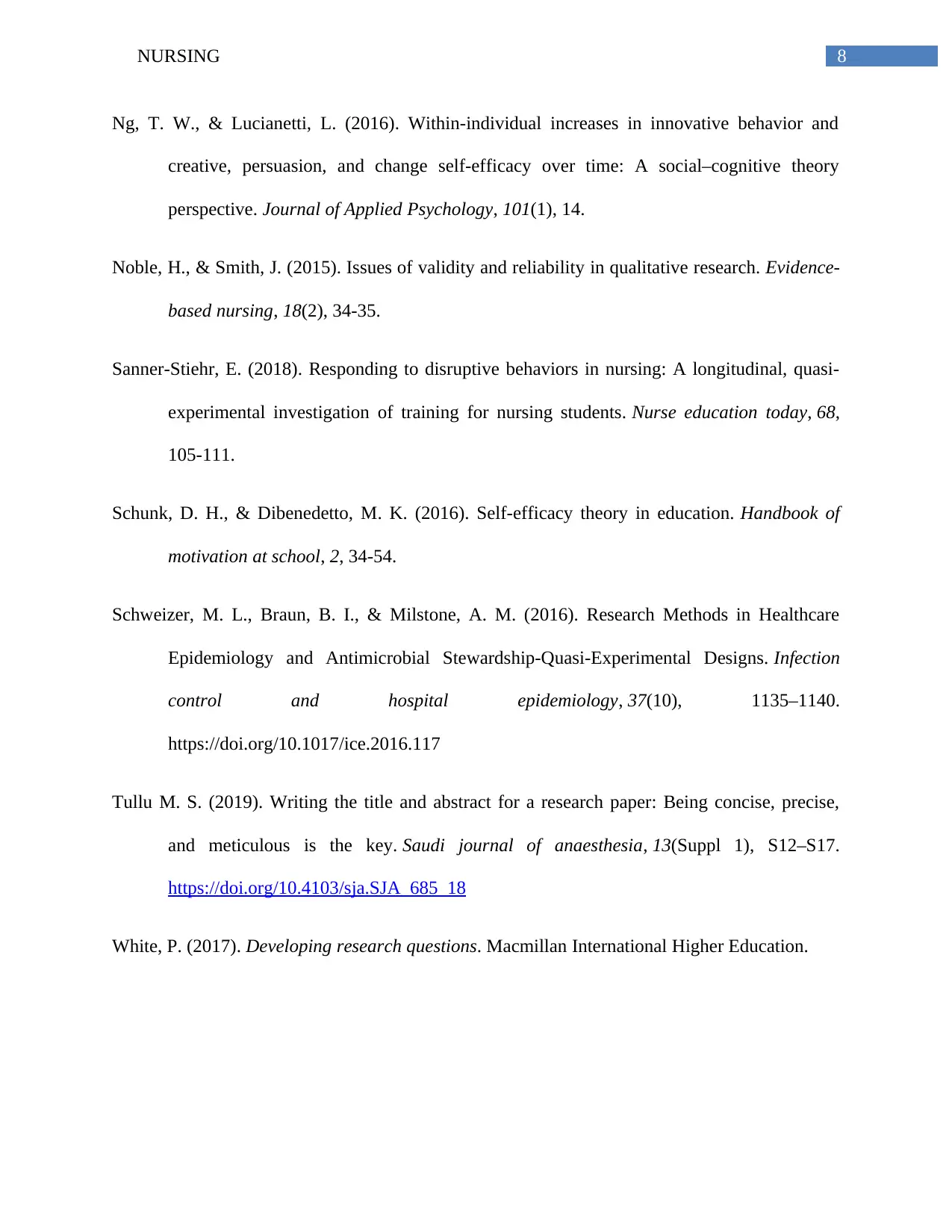
8NURSING
Ng, T. W., & Lucianetti, L. (2016). Within-individual increases in innovative behavior and
creative, persuasion, and change self-efficacy over time: A social–cognitive theory
perspective. Journal of Applied Psychology, 101(1), 14.
Noble, H., & Smith, J. (2015). Issues of validity and reliability in qualitative research. Evidence-
based nursing, 18(2), 34-35.
Sanner-Stiehr, E. (2018). Responding to disruptive behaviors in nursing: A longitudinal, quasi-
experimental investigation of training for nursing students. Nurse education today, 68,
105-111.
Schunk, D. H., & Dibenedetto, M. K. (2016). Self-efficacy theory in education. Handbook of
motivation at school, 2, 34-54.
Schweizer, M. L., Braun, B. I., & Milstone, A. M. (2016). Research Methods in Healthcare
Epidemiology and Antimicrobial Stewardship-Quasi-Experimental Designs. Infection
control and hospital epidemiology, 37(10), 1135–1140.
https://doi.org/10.1017/ice.2016.117
Tullu M. S. (2019). Writing the title and abstract for a research paper: Being concise, precise,
and meticulous is the key. Saudi journal of anaesthesia, 13(Suppl 1), S12–S17.
https://doi.org/10.4103/sja.SJA_685_18
White, P. (2017). Developing research questions. Macmillan International Higher Education.
Ng, T. W., & Lucianetti, L. (2016). Within-individual increases in innovative behavior and
creative, persuasion, and change self-efficacy over time: A social–cognitive theory
perspective. Journal of Applied Psychology, 101(1), 14.
Noble, H., & Smith, J. (2015). Issues of validity and reliability in qualitative research. Evidence-
based nursing, 18(2), 34-35.
Sanner-Stiehr, E. (2018). Responding to disruptive behaviors in nursing: A longitudinal, quasi-
experimental investigation of training for nursing students. Nurse education today, 68,
105-111.
Schunk, D. H., & Dibenedetto, M. K. (2016). Self-efficacy theory in education. Handbook of
motivation at school, 2, 34-54.
Schweizer, M. L., Braun, B. I., & Milstone, A. M. (2016). Research Methods in Healthcare
Epidemiology and Antimicrobial Stewardship-Quasi-Experimental Designs. Infection
control and hospital epidemiology, 37(10), 1135–1140.
https://doi.org/10.1017/ice.2016.117
Tullu M. S. (2019). Writing the title and abstract for a research paper: Being concise, precise,
and meticulous is the key. Saudi journal of anaesthesia, 13(Suppl 1), S12–S17.
https://doi.org/10.4103/sja.SJA_685_18
White, P. (2017). Developing research questions. Macmillan International Higher Education.
⊘ This is a preview!⊘
Do you want full access?
Subscribe today to unlock all pages.

Trusted by 1+ million students worldwide
1 out of 9
Related Documents
Your All-in-One AI-Powered Toolkit for Academic Success.
+13062052269
info@desklib.com
Available 24*7 on WhatsApp / Email
![[object Object]](/_next/static/media/star-bottom.7253800d.svg)
Unlock your academic potential
Copyright © 2020–2025 A2Z Services. All Rights Reserved. Developed and managed by ZUCOL.





